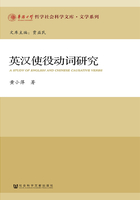
Abstract
With the analytical method of thematic roles of constructions, the markedness theory and causation rewriting, this book illustrates the relation and transformation among various transitive and intransitive events in the continuum of transitivity of verbs and expounds the causation and causative meaning of non-prototypical causative verbs. The research on classification, semantic functions and causative mechanism of both English and Chinese causative verbs throws light into the differences between English and Chinese causative constructions, transitivity of verbs, and non-prototypical causative constructions, if not the nature of language. Chinese college English learners made frequent and persistent errors in the use of non-prototypical causative verbs, so an enhanced awareness of the transformation of causative constructions and the causative meaning embedded in non-prototypical causative verbs is expected to facilitate the teaching and learning of these causative verbs.
Bulletpoints
1)The surfacing or unexpressedreflexive pronouns plays an important role in revealing the relation and transformation between various transitive and intransitive constructions and the interpretation of causativity of non-prototypical causative constructions.
2)The transitive, intransitive and“be+V-ed+PP”constructions of worry and other such lexicalized causative verbs can be transformed with little semantic change shows that the so called“adjective derived from verb”also entails causativity. The statal passive construction“be+V-ed+PP”is the state after the active involvement. Many constructions with intransitive verbs in surface structure are actually causative constructions with an omitted object/patient or an implicit reflexive pronoun.
3)The claim that the verb in inchoative construction is not an action verb and it is a statal verb is outwitted by the claim that it is a verb which incorporates causation and emphasizes the effect of causation.
4)The lexical causative construction and syntactic causative construction can be mutually transformed, enjoying the similar core semantic meaning, so to speak syntactic type causative constructions, a basic type, are widely applicable constructions, hence the essential construction of all causative constructions.
5)One important cause of frequent errors in the use of non-prototypical causative verbs is the incorporation of process and effect and various conflations of meaning for lexicalized causative verbs, which make it more difficult to interpret and even more so for productive purposes than causative constructions with all the semantic elements explicitly present in surface structure. The greater complexity of“be+V-ed+prep”constructions results from such concealed elements as“cause”, “energy”and“recipient of energy”in non-prototypical causative constructions.
Contribution of this book
1)By substantial examples and discussion this book shows analysis of thematic roles ofconstructions, the markedness theory and causation rewriting are able to explain and analyze non-prototypical causative constructions.
2)A deep exploration of the role of reflexive pronouns in explaining causation is done to uncover causation of non-prototypical causative constructions.
3)Based on the parsable and synthetic features of participants, a diagram to cover major types of causative constructions is presented, which serves as one feasible way to classify causative constructions.
4)The involve type of causative verbs are tentatively discussed and interpreted as non -prototypical causative verbs which are atelic and non -quantized with non-force recipients.
5)This book extends Beavers' s“affectedness”analysis model and shows the way to apply“effector”to cover agent and other causers and apply“affected”to cover patient and other recipients has the advantage of ease and wide operability.
Key words: causative verbs; thematic roles of constructions; reflexive pronouns; causation